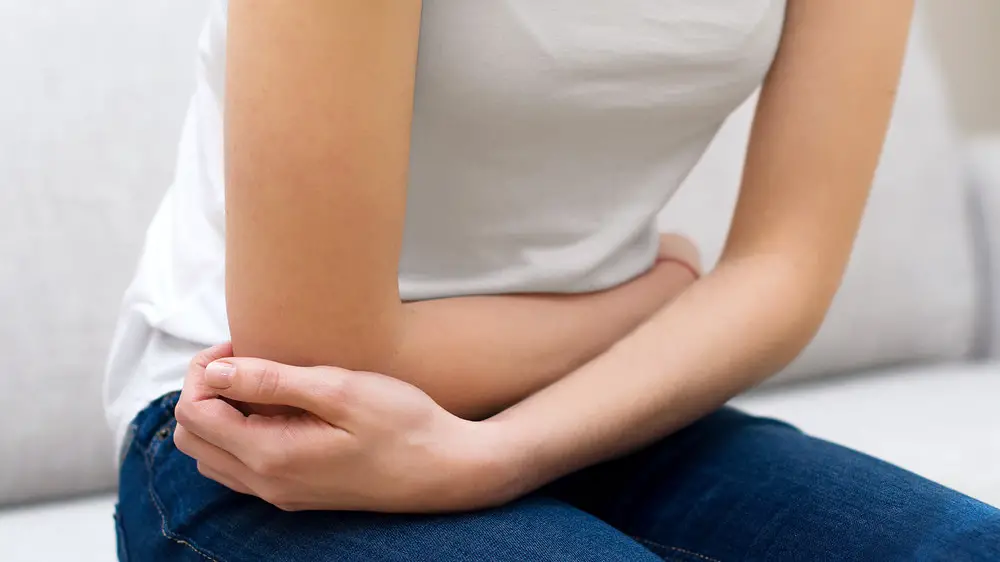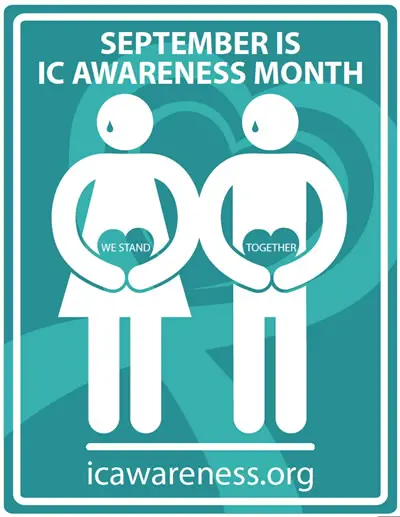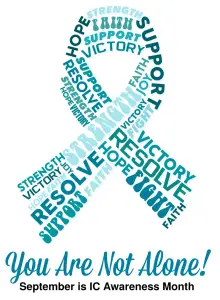Wednesday September 23, 2020
By: Lara Ahmed

September is interstitial cystitis (IC) awareness month, yet many people won’t even realize it because they might not even know that the medical condition exists. This isn’t the fault of the general public but because the reasons it remains in the shadows are almost as complicated as the condition itself.

What is Interstitial Cystitis?
Mayo Clinic describes IC as a chronic condition causing bladder pressure, pain in the bladder and sometimes even in the pelvic region. The degree of pain ranges from mild to severe. Interstitial cystitis falls under a category of similar conditions referred to as “painful bladder syndrome”.
Other common symptoms of interstitial cystitis include an urgent need to urinate and unusually increased frequency. Many also experience shooting pains in areas such as the lower back and legs. According to Harvard Health Online, Interstitial cystitis usually occurs in women between the ages of 20 and 50.
Why it remains in the shadows
Perhaps the greatest barrier with interstitial cystitis is that it is so hard to diagnose. Even women suffering from it often go their whole lives without ever realizing they had this condition. Interstitial cystitis is typically a diagnosis of exclusion. Since the condition resembles the symptoms of similar disorders and diseases, other possibilities need to be ruled out first such as UTIs (urinary tract infections) or other conditions like vulvodynia.
Another reason women may go undiagnosed is out of fear that they won’t be taken seriously by health practitioners. This often comes from their own past experiences, and studies suggest a basis for these claims. The New York Times cites studies where women were found more likely to be told their pain is simply a result of emotional distress. In one survey of more than 2,400 women with chronic pain, 83 percent said they felt they had “experienced gender discrimination from their health care providers”.

These experiences go hand in hand with other disorders usually referred to as “women’s diseases” , such as endometriosis. In countries were public discussion of urological, gynecological, and hormonal conditions are especially stigmatized, girls and women may believe their pain is just a natural part of being a woman. They often don’t want to take the risk of being further belittled by others.
The media too has only been bringing the issue to some public interest in the last few years, with social media in particular drawing attention. Now, people who suffer from the condition can connect with each other through online groups and pages.
What can we do about it?
Though men also suffer from the condition it is much more likely to affect women, according to the Nation Health Service (NHS) in the UK. In fact, research suggests that approximately 90% of interstitial cystitis patients are women. This problem should be framed as a feminist issue rooted in the need for women’s voices to be heard.

Seeking help for discomfort or pain is a necessary start and this goes beyond pain in the bladder area. If lower urinary tract symptoms last for over six weeks without having an infection or other clear cause interstitial cystitis should be considered a possibility, according to The Urology Care Foundation.
There’s no cure for interstitial cystitis, but treatments can offer some relief. Figuring out a treatment plan is a process of trial-and-error and what works bests varies from patient to patient. Watching what you eat can help alleviate symptoms such as by avoiding coffee or acidic foods. Websites and organizations such as “IC help” are dedicated to educating people on the condition. They also offer detailed guidelines on diagnosis and what to expect with treatment.
However, the first step for any one concerned should be to visit a doctor so they can recognize and treat any the issue- whether it is IC or anything else. In the last few years countries across the world have slowly begun to highlight the condition, especially within medical communities. Egypt and the rest of the Arab world can hopefully do the same in the years to come, by adding their voices to the wider conversation.
For more information visit: https://www.ichelp.org/about-ic/
Sources: https://www.urologyhealth.org/urologic-conditions/interstitial-cystitis
https://www.health.harvard.edu/a_to_z/interstitial-cystitis-a-to-z
https://www.nytimes.com/2018/05/03/well/live/when-doctors-downplay-womens-health-concerns.html
https://www.mayoclinic.org/diseases-conditions/interstitial-cystitis/symptoms-causes/syc-20354357
***If you liked this article, don’t forget to subscribe to our newsletter and receive our articles by email.
